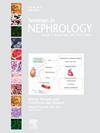重症疟疾急性肾损伤:溶血所致的严重并发症。
IF 3.5
3区 医学
Q2 UROLOGY & NEPHROLOGY
引用次数: 0
摘要
急性肾损伤(AKI)是疟疾的一种常见临床并发症,据报道,所有引起严重疾病的物种都有急性肾损伤,包括恶性疟原虫、诺氏疟原虫和间日疟原虫。疟疾期间的AKI因宿主和寄生虫因素而异,包括寄生虫在宿主红细胞内的生长潜力、红细胞溶解的程度以及寄生虫在微血管内的隔离能力。在这篇综述中,我们主要关注恶性疟原虫的发病机制和血管内溶血在AKI中的作用,通过消耗内源性血红蛋白和血红素清除剂,导致氧化应激和组织损伤。我们讨论黑水热的病因作为溶血性并发症严重疟疾,已上升的发病率。所有严重疟疾患者都应高度怀疑AKI,特别是当出现溶血特征时。最后,我们回顾了缓解溶血对严重疟疾肾损伤影响的潜在干预措施。鉴于非洲疟疾的高负担、严重疟疾中AKI的发病率以及人一生中疟疾发作的次数,需要考虑疟疾相关AKI对慢性肾脏疾病的累积影响。Semin Nephrol 36:x-xx©20XX Elsevier Inc.。版权所有。本文章由计算机程序翻译,如有差异,请以英文原文为准。
Acute Kidney Injury in Severe Malaria: A Serious Complication Driven by Hemolysis
Acute kidney injury (AKI) is a common clinical complication in malaria, with AKI reported across all species that cause severe disease, including Plasmodium falciparum, Plasmodium knowlesi, and Plasmodium vivax. AKI during malaria varies based on host and parasite factors, including the growth potential of the parasite within host red blood cells, the extent of red blood cell lysis, and the capacity of the parasite to sequester within the microvasculature. In this review, we focus primarily on P. falciparum pathogenesis and the role of intravascular hemolysis in AKI through the depletion of endogenous hemoglobin and heme scavengers, resulting in oxidative stress and tissue injury. We discuss the etiology of blackwater fever as a hemolytic complication in severe malaria that has been rising in incidence. All patients with severe malaria should have a high index of suspicion for AKI, particularly when hemolytic features are present. Finally, we review potential interventions to mitigate the impact of hemolysis on kidney injury in severe malaria. Given the high burden of malaria in Africa, the incidence of AKI in severe malaria, and the number of malaria episodes over a person’s lifetime, the cumulative impact of malaria-associated AKI on chronic kidney disease needs to be considered. Semin Nephrol 36:x-xx © 20XX Elsevier Inc. All rights reserved.
求助全文
通过发布文献求助,成功后即可免费获取论文全文。
去求助
来源期刊

Seminars in nephrology
医学-泌尿学与肾脏学
CiteScore
5.60
自引率
0.00%
发文量
27
审稿时长
6-12 weeks
期刊介绍:
Seminars in Nephrology is a timely source for the publication of new concepts and research findings relevant to the clinical practice of nephrology. Each issue is an organized compendium of practical information that serves as a lasting reference for nephrologists, internists and physicians in training.
 求助内容:
求助内容: 应助结果提醒方式:
应助结果提醒方式:


